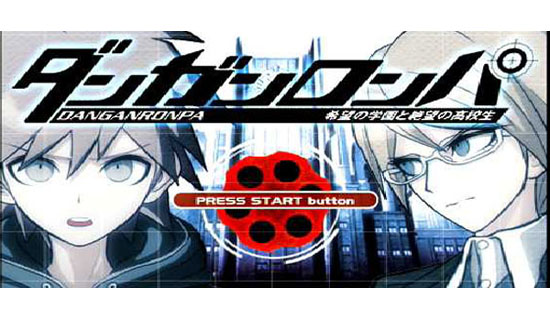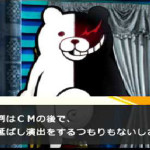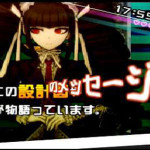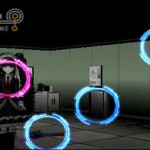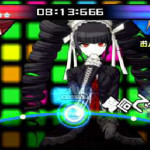Since Danganronpa mania didn’t sweep the west until 2014 when it was re-released on the Vita (or possibly even when the anime was aired in 2013), many forget that it began life way back in 2010 on the Vita’s predecessor: the PSP. Though its original platform and release date do nothing more to explain its uniqueness. It borrows from so many pieces of media and genres of games that it makes one’s head spin, and merges things both western and Japanese. But there is a very good reason why it caught fire in the west as it did: It takes the best parts of everything involved and mixes them all together.
The first bit of Danganronpa’s uniqueness appears before you even see the title screen: Its name. It’s a combination of the word “dangan” (Literally “bullet”, though in this case it refers to the words that you fire as bullets in the trial sections of the game) and “ronpa” (Literally “refutation”, which is exactly what you are doing to the arguments of other students in the trial sections by using your “bullets”). The fact that it is a combination of two words that don’t naturally fit together make it difficult to coherently translate, so it was a good decision to leave that portion of the title un-localized when it was brought to the west.
In order to describe what type of game Danganronpa is, we must first discuss the story. This is far and away the game’s main appeal, so if you have a fondness for well-written game stories that make you think, this is already required playing. The game takes place in a school called “Kibougamine Gakuen” (“Hope’s Peak Academy”) that only admits “Ultimate” students, each of which are the best at something (a sport, singing, etc.). What the students don’t know though, is that this school is nothing more than a sick game in which the only way that they can “graduate” back to the outside world is to kill other students and not be convicted in the class trials that take place after a murder. As you may guess, if a student is correctly found guilty then he or she will be executed. The academy and all of its proceedings are headed up by Monokuma: An evil and sadistic, yet also strangely funny and lovable bear who is undoubtedly high on the list of the best written video game characters for any who have played list (also voiced by Ouyama Nobuyo, most well known for voicing robot-cat Doraemon in the anime of the same name from 1979 to 2005). In fact the entire cast of characters is extremely well written and voiced, reinforcing the already strong story. It’s a pity that the game isn’t fully voiced (important cut scenes and class trials are, but otherwise you get the classic visual novel treatment of just hearing a character speak a line or phrase periodically), though it may have been a matter of capacity on the UMD since there’s quite a bit of dialogue.
Based on the premise alone, an obvious influences from the western film world may be the “Saw” series. Producer Terasawa Yoshinori has confirmed in interviews that psychological horror movies, the Saw series and “Cube” in particular, were Danganronpa’s biggest conceptual influences. Scenario writer Kodaka Kazutaka also stated in an interview that he was aiming for a pop mystery story, and was heavily influenced by the work of Ishin Nishio: A writer of both mystery novels and manga who is best known for the “Death Note Another Note” novel, and the creation of the “Monogatari” series (“Bakemonogatari”, “Nisemonogatari”, etc.). He also revealed on twitter that the story was inspired by “Illbleed”, A Dreamcast survival-horror game that was a commercial failure despite its innovative mechanics of trap detection and obviously B-movie-esque presentation. The tweet can be found in English here.
Of course the “pop mystery” feeling that Danganronpa achieved would not have been possible without its distinctive art style, featuring the character designs of Komatsuzaki Rui. Making all blood found in the game pink may have partially been a mechanism to bump down the CERO rating of this game, but it also added to the distinctive pop style and served to put more focus on story rather than gore. The music by Takada Masafumi also helps the game achieve its unique identity, with its electronic-pop sound.
As a game Danganronpa borrows from several different genres, though primarily two: The visual novel and the point-and-click adventure game. Both genres have long and rich histories at this point, and this is not the first time that they have met so closely. In fact “Portopia Renzoku Satsujin Jiken” (“The Portopia Serial Murder Case”), which is often credited with creating the visual novel genre way back on the Famicom and various Japanese home computers, was very much made according the western adventure game formula at the time (it used a text-parser in the computer versions and a set of select-able commands in the Famicom version). From there visual novels grew further and further apart from their western adventure game ancestors, so Danganronpa acts as a long time reunion between them.
While it was originally planned to be strictly a visual novel, the idea was scrapped due to the slipping popularity of the genre in Japan at the time (you could argue that it’s made more of a comeback since then). Then after the scenario was written, adventure game elements were added as the main method of exploring the academy between sets of character dialogue, as well as the means for gathering evidence for a class trial by simply examining items in a room with a cursor. The class trials themselves are one of Danganronpa’s most unique features. They are somewhat similar those found in popular visual novel/adventure game series “Gyakuten Saiban” (“Ace Attorney”), but with some action-y twists. You literally fire a piece of evidence or testimony as a bullet into the statement that you want to refute, with your aim and timing actually being important factors. There are even sections that are short rhythm games, as you refute a specific character’s heated arguments in a “Machine Gun Talk” (localized to be “Bullet Time Battle”).
Danganronpa is a very important game that proved Japan was still capable of innovating on a portable game level budget during a time when people were saying that Japan was done for in the game world. That being said, at times it was very hard for me to make it all the way through. In recent years I’ve discovered a fondness for the visual novel genre (as long as the subject matter is of interest and the writing is good), if nothing else because it acts as good Japanese reading practice. I also really enjoyed the class trials due to the previously mentioned unique elements, as well as the fact that it challenged me to be able to process Japanese words quickly or face failure (I’m a bit ashamed to admit that I had to turn to a walk through a few times). The problem is that I did not come into this liking adventure games, and unfortunately Danganronpa did not change my opinion on that whatsoever.
Large portions of the game involve selecting items in a room until you find the right things, or speaking to characters until you find the right one that will allow you to progress. I recognize that Danganronpa minimizes the overhead of this as much as it possibly can, and it certainly doesn’t follow the classic adventure game rule of “You do the wrong thing and you die”. And while I do find comfort in gaming monotony in a few different forms, this is not one of them. Those who are adventure game fans and are not turned off by the walls of text that a visual novel can throw at you may consider this to be a near perfect game. And though I did not particular enjoy the adventure game sections themselves, I did appreciate the connection between them and the class trials that came in the form of various abilities gained from spending time talking to each of the students during free time. It did create the consequence that you can’t get certain abilities if you don’t talk to specific characters before they are either murdered or convicted during a class trial, but this should only really bother completionists as these abilities are not at all necessary for making it through the game.
A sequel would be released on the PSP in 2012, and an improved Vita compilation of both games in 2013 (though the Vita versions would be released separately in the west, one year later). There are also a handful of spin-offs on Android and iOS, as well as one on the Vita. If that isn’t enough for you, there’s also an anime and manga series, along with various audio drama CDs. This all proves that Danganronpa is a rare Japanese new game IP that actually has managed to turn itself into a successful franchise. Its high level of quality and creativity make its success well deserved, and as long as that isn’t squandered away on terrible spin-offs or numerous soulless sequels, it will likely continue to be highly regarded for a long time.
